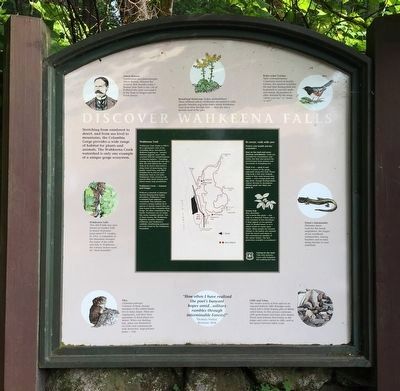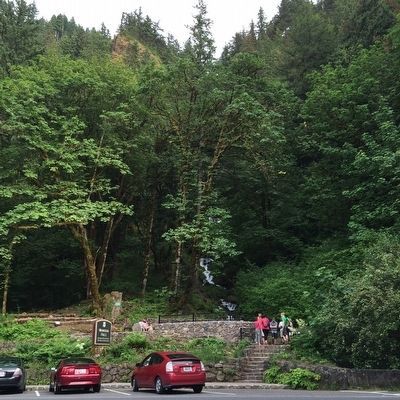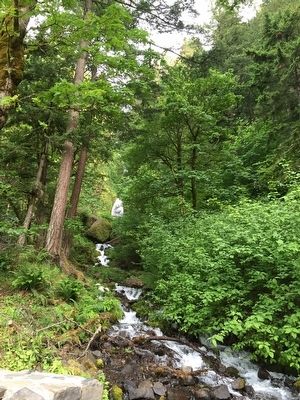Near Corbett in Multnomah County, Oregon — The American West (Northwest)
Discover Wahkeena Falls
Wahkeena Falls. This 242 ft falls was once known as Gordon Falls in honor of pioneer hald-owner F.E. Gordon. In 1915, a committee of the Mazamas changed the name of the creek and falls to Wahkeena—the Yakima Indian word for “most beautiful.”
Pika (Ochotona princeps). Colonies of these chunky members of the rabbit family live in talus slopes. Pikas are vegeterians, and they store quantities of dried plans for winter. When not making hay, pikas sun themselves on rocks and communicate with distinctive, high-pitched barks—Enk!
Cliffs and Talus. The erosive action of frost and ice on exposed bedrock cliffs dislodges rocks which fall to form sloping piles of debris called talus. As this process continues, cliffs glow steeper and talus piles deeper. Plants and animals find homes in the ledges and caes carved in cliffs, and in the spaces between fallen rocks.
Dunn’s Salamander Plethodon dunni. Look for this hardy amphibian, the largest of our woodland salamanders, among boulders and in talus along streams or near waterfalls.
Rufus-sided Towhee Pipilo erythrophthalmus. Commonly found in brushy habitat, this sparrow scratches the leaf litter kicking both feet backwards to uncover seeds and insects. Its presence is often detected by the songs “drink your test,” or “meeu ’u ’we?”
Broad-leaf Stonecrop (Sedum spathulifolium). These brilliant yellow wildflowers are partial to cliffs, gravelly benches and talus slopes along Wahkeena Trail from May through June—the are also a favorite food of the pika.
Simon Benson. Lumberman and philanthropist Simon Benson, donated the property that includes today’s Benson State Park to the City of Portland who later conveyed it to the State of Oregon and the Forest Service.
“How often I have realized the poet’s buoyant hopes amid ... solitary rambles through interminable Forests!” —Thomas Nuttal, Botanist 1834
Wahkeena Trail. Wahkeena Trail climbs to 900 feet for a specacular view of the Columbia River, described by Ruyard Kippling as “penned between gigantic stone walls crowned with the ruined bastions of Oriental palaces.” Traveling among rocks festooned with deer fern, the trail follows the creek close to its source and enters a steep forest of moss-hung vine maple, sword fern, and 200-foot Douglas firs to end at Larch Mountain Trail in 2.8 miles. Wahkeena Trail connects several other trails enroute and allows many loop possibilities.
Wahkeena Creek—Isolated and Unique. Without a network of tributary streams flowing from higher elevations, Wahkeena Creek is isolated from adjacent watersheds. This isolation has created a unique habitat for 8 species of aquatic insects that are only found in the Columbia River Gorge. No other watershed in the Pacific Northwest can yet claim this many endemic species. Two of these insects, the Wahkeena flightless stonefly (Nemoura wahkeena) and Anderson’s caddisfly (Neotrenuma andersoni) are only found in the Wahkeena watershed.
Be aware, walk with care. Protect your health and the ecosystem’s.
Stay on the trail and never shortcut switchbacks. Trails are provided for convenience and safety, but they also protect the environment from erosion and thousands of trampling feet.
Pack it in—pack it out! Litter is scarce in the gorge, especially along this trail. Please help keep it this way! Nobody wants to hike trails littered with debris—even orange peels and egg shells, though biodegradable, require decades to decompose. Always pack out what you pack in.
Poison Oak Rhus diversilaba. Get to know this plant—but only at a distance! Poison oak is very common at low elevations. It may appear as low ground cover is shaded areas, or as a robust shrub on sunny open slopes. Many people are severely allergic to the potent oils released from the leaves and stems of this cantankerous member of the sumac family. The best protection is avoidance!
U.S. Forest Service. Caring for the land. Take only pictures. Leave only footprints. Kill nothing but time.
Erected by U.S. Forest Service.
Topics. This historical marker is listed in these topic lists: Environment • Natural Features. A significant historical year for this entry is 1915.
Location. 45° 34.515′ N, 122° 7.677′ W. Marker is near Corbett, Oregon, in Multnomah County. Marker is on Historic Columbia River Highway, 5 miles east of Bridal Veil, on the right when traveling east. It is at the start of the trail. Touch for map. Marker is in this post office area: Corbett OR 97019, United States of America. Touch for directions.
Other nearby markers. At least 8 other markers are within 7 miles of this marker, measured as the crow flies. Welcome to Multnomah Falls (approx. half a mile away); Simon Benson (approx. 0.6 miles away); Oneonta Gorge (approx. 2.7 miles away); Oneonta Tunnel (approx. 2.7 miles away); Lewis and Clark Expedition (approx. 5.6 miles away); Rooster Rock State Park (approx. 5.6 miles away); Camping Among the Giants (approx. 5.6 miles away); Samuel C. Lancaster (approx. 6.2 miles away). Touch for a list and map of all markers in Corbett.
Credits. This page was last revised on June 16, 2016. It was originally submitted on December 2, 2015, by J. J. Prats of Powell, Ohio. This page has been viewed 376 times since then and 15 times this year. Photos: 1, 2, 3. submitted on December 2, 2015, by J. J. Prats of Powell, Ohio.


